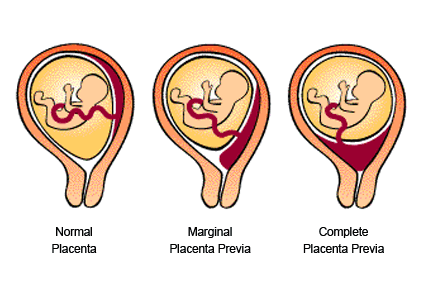The premature rupture of membranes when the egg is opened during pregnancy before the start of work (beyond 12 hours because some risk of infection)
Etiologies:
Mechanical causes distension of the egg (hydramnios, twin pregnancy) or lack of accommodation (vicious or high presentation); low lying placenta; cervical incompetence.
Alteration of membranes: is the act of an infectious amnionitis, its origin is often urine
Clinic:
Spontaneous rupture of membranes in the latter boils functionally in one sign: amniotic hydrorrhea.
It appears from a beating; it is first abundant and will continue permanently; flow increases with some changes of positions and especially by mobilizing the presentation to the touch (sign Farabœuf)
PROLAPSED CORD:
This is the fall of the cord before the presentation, accident period of work; this is the most serious movement of cordent. The real prolapse is when the fetus is open (if it is not it is the prone position)
● Etiology: abnormal presentation (transverse lie, breech presentation).
In the vertex well bent and well accommodated prolapse does not exist.
Discomfort to accommodation promotes prolapse: narrowed basins, tumors paevia, twin pregnancy, the smallness of the fetus, the simple multiparity (for relaxation of uterine walls); placenta previa; excess cord length; hydramnios (very high mobility of the fetus during the sudden arrival); decrease in pressure in the vessels of the cord; marginal cord insertion; error maneuver during a speech (sudden artificial rupture of membranes).
● Consequences: cord compression (it is more dangerous in the cephalic presentation); desiccation; => Fetal distress.
● Clinics: tachypnea, agitation, cyanosis (broad chest closets, more livid than abdominal blue); hacking cough;shock; DIC (uterine bleeding)
Obstetric etiologies 3 DIC are dominant:
– Placental hematoma
– Prolonged retention of dead fetus in utero
Very rare but extremely serious accident in the last phase of the work or the time of issue.
● Contributing factors: spontaneous or artificial rupture of membranes; length and difficulty of the work, violence uterine contractions; artificial extractions; the use of oxytocin; soft tissue lesions (cervical lacerations …) high rupture of membranes; low insertion of placenta.
● Treatment: Caesarean section is the presentation and some few to be expansion.
In the prone position caesarean section is the rule.
PROBLEMS FOR INCLUSION CORD:
Normally the cord insert in the middle of placental disk or remote edges.
When the insertion is done at the very edge it is called snowshoeing or marginal, this provision favors prolapse.
The velamentous insertion is near but outside the placental edge (on membranes).
The consequences are rare: cord prolapse; compression of membranous vessels by the presentation during the engagement; Benkiser bleeding by vascular rupture at the opening of the egg.
Clinical forms:
When the membranes rupture early in pregnancy, abortion is the rule.
If pregnancy does not interrupt the fetus continues to be developed: childbirth is still too early, often by the seat, the child is marked deformation
Without treatment half of women into labor in the hours after birth and 80% in 24 hours; RPM is an important factor for prematurity, it operates with other elements in the preterm birth rate (uterine contraction, breakthrough bleeding and cervical dilatation).


Leave a Reply